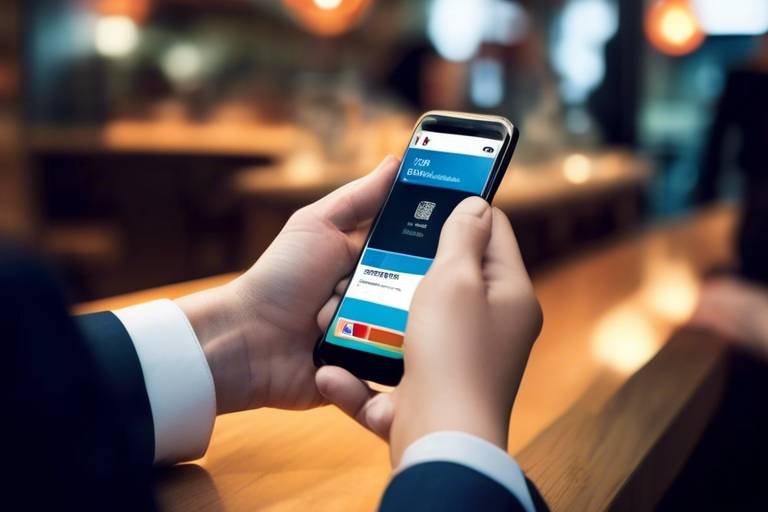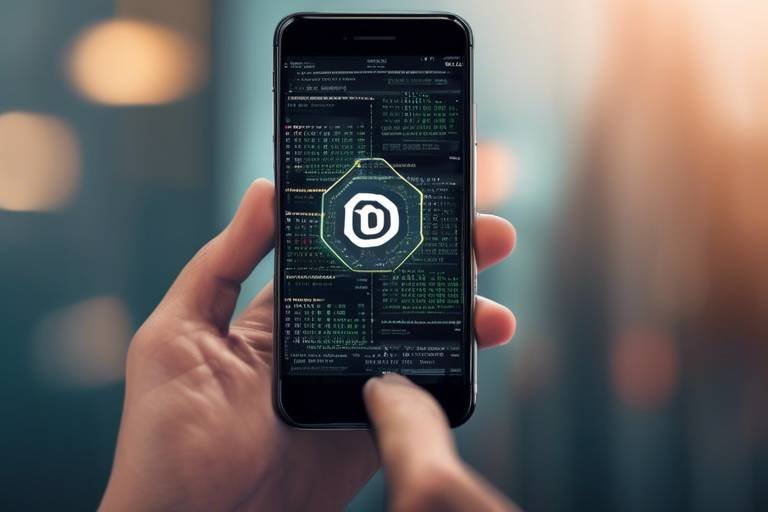Evaluating the Best Crypto Exchanges for Beginners
In the rapidly evolving world of cryptocurrency, choosing the right exchange can feel like navigating a maze. With countless options available, how do you pick the one that suits your needs best? This article explores essential factors to consider when choosing a crypto exchange, highlighting top platforms, user experiences, security measures, and tips for beginners to navigate the cryptocurrency market effectively. Whether you're looking to invest in Bitcoin, Ethereum, or any other digital asset, understanding the landscape of crypto exchanges is crucial for your success.
So, what exactly are crypto exchanges? Think of them as the marketplace for digital currencies, where you can buy, sell, or trade cryptocurrencies. In essence, they serve as intermediaries, connecting buyers and sellers. There are two main types of crypto exchanges: centralized and decentralized. Centralized exchanges (CEX) are run by companies that facilitate trading, while decentralized exchanges (DEX) operate without a central authority, allowing users to trade directly with one another. Understanding these types is essential for beginners, as each comes with its own set of advantages and challenges.
When diving into the world of cryptocurrency, identifying crucial features of a crypto exchange is vital. Here are some key aspects to consider:
- User Interface: A clean, intuitive interface can make all the difference, especially for beginners. You want to feel comfortable navigating the platform without getting lost in a sea of charts and data.
- Trading Fees: Always check the fee structure. Some exchanges charge high fees that can eat into your profits, while others offer more competitive rates.
- Security Protocols: With the rise of cyber threats, security should be a top priority. Look for exchanges that offer robust security measures.
- Customer Support: If you run into issues, having responsive customer support can save you a lot of headaches.
Security is a paramount concern when it comes to cryptocurrency exchanges. The last thing you want is to wake up one day and find your funds missing due to a hack. Therefore, it’s crucial to choose an exchange that has stringent security measures in place. Some of the protective measures to look for include:
Two-factor authentication (2FA) is a security feature that adds an extra layer of protection to your account. By requiring a second form of verification—such as a code sent to your mobile device—it makes unauthorized access significantly more difficult. Think of it as having a lock on your front door and then adding a deadbolt for good measure.
Cold storage refers to keeping your cryptocurrencies offline, away from potential online threats. This is like storing your valuables in a safe rather than leaving them out in the open. Many reputable exchanges utilize cold storage methods to protect users' assets. When selecting an exchange, inquire about their cold storage practices to ensure your investments are well-protected.
A user-friendly interface is vital for beginners. If you’re new to cryptocurrency, the last thing you want is to be overwhelmed by complex charts and jargon. An intuitive design that makes navigation easy can significantly enhance your trading experience. Look for exchanges that offer educational resources, tutorials, and demo accounts to help you familiarize yourself with the platform before diving in.
Now that we've covered the fundamental aspects, let's take a closer look at some of the most beginner-friendly crypto exchanges available today. Each platform has its unique features, pros, and cons, making them suitable for different types of users.
Coinbase is often the first name that comes to mind when discussing beginner-friendly exchanges. Known for its simplicity, it offers a straightforward interface that makes buying and selling cryptocurrencies a breeze. With a variety of cryptocurrencies available and a wealth of educational resources, it’s no wonder that Coinbase is a top choice for those new to cryptocurrency trading. However, be mindful of the fees, as they can be higher compared to other exchanges.
On the other hand, Binance stands out for its extensive offerings. With a vast range of trading pairs and lower fees, it caters to both beginners and experienced traders. Binance also provides a plethora of educational resources, ensuring that newcomers can learn as they trade. However, its interface can be a bit overwhelming for absolute beginners, so it's essential to take your time to explore and understand the platform.
What is a crypto exchange?
A crypto exchange is a platform that allows users to buy, sell, or trade cryptocurrencies. They serve as intermediaries connecting buyers and sellers.
Are crypto exchanges safe?
While many exchanges implement robust security measures, risks still exist. Always research the exchange's security protocols before investing.
Can beginners use crypto exchanges?
Absolutely! Many exchanges are designed with beginners in mind, offering user-friendly interfaces and educational resources.
What should I look for in a crypto exchange?
Key factors include user interface, trading fees, security measures, and customer support.

Understanding Crypto Exchanges
So, what exactly are crypto exchanges? In the simplest terms, they are platforms that facilitate the buying, selling, and trading of cryptocurrencies. Think of them as your local marketplace, but instead of fruits and vegetables, you're dealing with digital assets like Bitcoin, Ethereum, and countless altcoins. These exchanges play a crucial role in the cryptocurrency ecosystem, acting as intermediaries that allow users to trade their fiat money (like dollars or euros) for cryptocurrencies and vice versa.
There are primarily two types of crypto exchanges: centralized exchanges (CEX) and decentralized exchanges (DEX). Centralized exchanges are run by companies that act as intermediaries, meaning they hold your funds and facilitate trades on your behalf. They are typically user-friendly and offer a wide range of services, but they do require you to trust the exchange with your assets. On the other hand, decentralized exchanges allow users to trade directly with one another without a middleman. This method often provides more privacy and control over your funds but can be more complex for beginners to navigate.
Understanding how these exchanges operate is essential for anyone looking to dive into the world of cryptocurrency trading. Here’s a quick rundown of their primary functions:
- Trading: This is the core function of any exchange, allowing users to buy and sell cryptocurrencies.
- Wallet Services: Most exchanges provide wallet services to store your cryptocurrencies securely.
- Market Information: Exchanges offer real-time data on price movements, trading volumes, and market trends, which are crucial for making informed trading decisions.
As a beginner, it’s vital to familiarize yourself with these concepts. The world of crypto can seem overwhelming at first, but understanding the role of exchanges will help you navigate it more confidently. It's like learning the rules of a game before you play; once you know how it works, you can make better decisions and avoid costly mistakes.
Moreover, crypto exchanges often come with various features tailored to different user needs. Some offer advanced trading options like margin trading and futures, while others focus on simplicity and ease of use, making them perfect for beginners. By knowing the types of exchanges and their functions, you’ll be better positioned to choose the right platform that aligns with your trading goals.
In conclusion, crypto exchanges are the backbone of the cryptocurrency market. They provide the necessary infrastructure for trading and investing in digital assets. As you embark on your crypto journey, remember that understanding these platforms is key to your success in the ever-evolving world of cryptocurrency.

Key Features to Look For
When diving into the world of cryptocurrency, selecting the right exchange can feel like navigating a maze. It’s not just about buying and selling; it’s about finding a platform that meets your needs and makes your trading experience smooth and enjoyable. So, what should you be looking for? Here are some crucial features that can significantly influence your trading journey.
First and foremost, user interface plays a critical role. A well-designed interface can make or break your experience, especially if you're a beginner. Imagine trying to navigate a complex website with confusing layouts—frustrating, right? A clean, intuitive design helps you focus on trading rather than figuring out how to use the platform. Look for exchanges that offer customizable dashboards, easy navigation, and helpful tutorials to guide you through the process.
Next up is trading fees. Every exchange has its own fee structure, and these costs can add up quickly if you're not careful. Some platforms charge a flat fee per trade, while others may take a percentage of your transaction. It’s essential to choose an exchange that balances competitive fees with the features you need. Here’s a quick comparison of fee structures from a few popular exchanges:
| Exchange | Trading Fee | Withdrawal Fee |
|---|---|---|
| Coinbase | 1.49% per trade | $0.15 for Bitcoin |
| Binance | 0.1% per trade | 0.0005 BTC for Bitcoin |
| Kraken | 0.16% maker, 0.26% taker | 0.0005 BTC for Bitcoin |
Another vital aspect to consider is security protocols. The cryptocurrency market can be a wild west of sorts, with hackers always on the prowl. So, it’s crucial to choose an exchange that prioritizes the safety of your funds. Look for features like two-factor authentication (2FA), which adds an extra layer of security to your account. This means that even if someone has your password, they won't be able to access your account without a second form of verification, like a code sent to your phone.
In addition to 2FA, consider whether the exchange uses cold storage solutions for cryptocurrencies. Cold storage means that the majority of your assets are kept offline, away from the reach of online threats. This is akin to storing your valuables in a safe rather than leaving them out in the open. Always check if the exchange has a clear policy on how they secure their users' assets.
Lastly, don't underestimate the importance of customer support. When you're dealing with your hard-earned money, having access to reliable support can be a lifesaver. Look for exchanges that offer multiple ways to reach out, such as live chat, email, or phone support. A responsive support team can help you resolve issues quickly, ensuring that your trading experience remains as smooth as possible.
In summary, when selecting a crypto exchange, keep an eye out for user-friendly interfaces, transparent trading fees, robust security measures, and responsive customer support. These features can greatly enhance your trading experience and help you navigate the cryptocurrency market with confidence.
- What is the safest crypto exchange? The safest exchange often depends on your individual needs, but look for those with strong security measures, including 2FA and cold storage.
- How do I know if an exchange is reputable? Research user reviews, check for regulatory compliance, and see how long the exchange has been operating in the market.
- Are there fees for using crypto exchanges? Yes, most exchanges charge trading and withdrawal fees, so it's essential to review their fee structure before committing.

Security Measures
When it comes to trading cryptocurrencies, security should be at the forefront of your mind. The digital landscape is fraught with risks, and the last thing you want is to wake up one day to find your hard-earned investments vanished into thin air. So, how can you protect yourself? It all starts with understanding the security measures that reputable crypto exchanges put in place to safeguard your funds and personal information.
First and foremost, a reliable exchange should implement robust security protocols. This includes encryption technology to protect sensitive data, as well as regular security audits to identify and mitigate potential vulnerabilities. But that’s just the tip of the iceberg. Let’s dive deeper into some of the key security features you should be on the lookout for:
- Two-Factor Authentication (2FA): This is a must-have for any serious trader. It adds an extra layer of security by requiring not only your password but also a second form of identification, typically a code sent to your mobile device. Imagine trying to break into a vault that requires both a key and a secret code; that’s essentially what 2FA does for your crypto account.
- Cold Storage Solutions: Most reputable exchanges keep the majority of their assets in cold storage, which means they are stored offline and are less susceptible to hacking attempts. Think of it like keeping your cash in a safe rather than your wallet. This method significantly reduces the risk of theft.
- Insurance Policies: Some exchanges offer insurance for your digital assets, providing an added layer of peace of mind. If the exchange were to suffer a breach, your funds could be covered, similar to how your bank deposits are insured by federal agencies.
Furthermore, it’s essential to be aware of the exchange’s track record regarding security breaches. Researching past incidents can provide insights into how well the platform responds to threats. A transparent exchange will openly discuss any security breaches and how they handled them, which can be a good indicator of their commitment to user safety.
In addition to these measures, always remember that your personal security practices are just as crucial. Use strong, unique passwords for your accounts, and never share your private keys with anyone. It’s like giving someone the keys to your house; you wouldn’t do that lightly, right?
In conclusion, while no system is entirely foolproof, choosing an exchange with strong security measures can significantly reduce your risk of falling victim to cyber threats. By staying informed and proactive about security, you can trade with confidence in the ever-evolving world of cryptocurrency.
Q: What is two-factor authentication (2FA)?
A: Two-factor authentication (2FA) is a security process that requires two different forms of identification before granting access to an account. This typically includes something you know (like your password) and something you have (like a code sent to your mobile device).
Q: Why is cold storage important?
A: Cold storage is crucial because it keeps your cryptocurrencies offline, making them less vulnerable to hacking attempts. It’s a safe way to store your assets, similar to keeping cash in a safe rather than in your pocket.
Q: What should I do if I suspect my account has been compromised?
A: If you suspect your account has been compromised, immediately change your password, enable two-factor authentication if you haven’t already, and contact the exchange’s customer support for assistance. They can help you secure your account and investigate any suspicious activity.

Two-Factor Authentication
In today's digital landscape, where cyber threats loom large, Two-Factor Authentication (2FA) has become a crucial line of defense for securing your cryptocurrency accounts. But what exactly is 2FA? Simply put, it’s an extra layer of security that requires not just a password and username but also something that only the user has on them. This could be a physical device, a smartphone app, or even a biometric factor like a fingerprint. Think of it as a double lock on your front door—just having the key isn’t enough; you also need to turn the deadbolt to ensure maximum protection.
When you enable 2FA on your crypto exchange account, you significantly reduce the risk of unauthorized access. For instance, if someone were to steal your password, they would still need that second form of verification to gain entry. This makes it much harder for hackers to compromise your account. Most exchanges offer various methods for 2FA, including:
- Authenticator Apps: Applications like Google Authenticator or Authy generate a time-sensitive code that you must enter along with your password.
- SMS Verification: A code is sent to your registered phone number, which you need to input during the login process.
- Hardware Tokens: Devices like YubiKey provide an additional layer of security by generating unique codes for authentication.
While 2FA significantly enhances your account's security, it's essential to choose the right method that suits your lifestyle. For instance, while SMS verification is convenient, it can be vulnerable to SIM swapping attacks. On the other hand, authenticator apps and hardware tokens are generally considered more secure options. Regardless of the method you choose, enabling 2FA is a no-brainer for anyone serious about protecting their digital assets.
In conclusion, Two-Factor Authentication is not just a recommendation; it’s a necessity in the world of cryptocurrency. By implementing 2FA, you’re taking a proactive step in safeguarding your investments and personal information. Remember, in the realm of crypto, it’s always better to be safe than sorry!
Q: What happens if I lose access to my 2FA device?
A: If you lose access to your 2FA device, most exchanges provide recovery options. This may include backup codes that you should have saved when setting up 2FA or customer support assistance to regain access.
Q: Is 2FA foolproof?
A: While 2FA significantly enhances security, it is not entirely foolproof. It is important to combine it with other security measures such as strong passwords and regular account monitoring.
Q: Can I use multiple 2FA methods?
A: Yes, some exchanges allow users to enable multiple 2FA methods for added security. This can provide a fallback option if one method fails.

Cold Storage Solutions
When it comes to securing your cryptocurrency, cold storage solutions are akin to putting your valuables in a safe rather than keeping them in a drawer. Cold storage refers to keeping your digital assets offline, away from the prying eyes of hackers and cybercriminals. This method is crucial for anyone serious about protecting their investments, especially beginners who might not yet be familiar with the various threats in the crypto landscape.
There are several types of cold storage methods available, each with its own advantages and disadvantages. The most common forms include hardware wallets, paper wallets, and even air-gapped computers. Let's break these down:
- Hardware Wallets: These are physical devices specifically designed to store cryptocurrencies securely. They allow users to manage their assets without being connected to the internet, minimizing the risk of online breaches. Popular options include Ledger and Trezor, which offer user-friendly interfaces and robust security features.
- Paper Wallets: A paper wallet involves printing your cryptocurrency keys on a piece of paper. While this method is highly secure against online threats, it comes with its own risks. If the paper is lost, damaged, or destroyed, you could lose access to your funds forever. Therefore, it's essential to store it in a safe place, just like you would with cash or important documents.
- Air-Gapped Computers: This method involves using a dedicated computer that is never connected to the internet. You can generate and store your private keys on this device, ensuring that they are completely isolated from online threats. However, this requires a bit more technical know-how and can be cumbersome for beginners.
While cold storage offers excellent protection, it's also important to understand that no solution is foolproof. Users should adopt best practices like regularly updating their software, creating backups, and using strong passwords to further enhance their security. Remember, the goal is to make it as difficult as possible for unauthorized individuals to access your assets.
In conclusion, investing in cold storage solutions is a smart move for anyone looking to safeguard their cryptocurrency. By keeping your assets offline, you significantly reduce the risk of theft and hacking. As you navigate the exciting world of crypto, consider these methods as essential tools in your security arsenal. After all, a secure investment is a smart investment!

User Experience and Interface
When it comes to navigating the often complex world of cryptocurrency, user experience (UX) and interface design play a crucial role, especially for beginners. Imagine stepping into a bustling marketplace for the first time; if the stalls are poorly organized and the signs are hard to read, you might feel overwhelmed and confused. The same principle applies to crypto exchanges. A well-designed interface can make all the difference in your trading journey, allowing you to focus on making informed decisions rather than grappling with complicated navigation.
A user-friendly interface typically includes a clean layout, intuitive navigation, and helpful features that guide users through the trading process. For instance, a dashboard that clearly displays your portfolio, current market prices, and trading options can significantly enhance your experience. Additionally, many platforms offer tutorials or demo accounts that allow you to practice trading without risking real money. This can be particularly beneficial for beginners who are still getting accustomed to the mechanics of buying and selling cryptocurrencies.
Furthermore, the speed and responsiveness of the platform are also vital. A slow-loading website or app can lead to missed opportunities, especially in the fast-paced world of crypto trading. Therefore, it’s essential to choose an exchange that not only looks good but performs well under pressure. Many users also appreciate features like customizable dashboards, where they can arrange their tools and information according to their preferences. This level of personalization can make trading feel more intuitive and less daunting.
Another aspect to consider is the availability of mobile apps. In today’s fast-moving environment, being able to trade on the go is a significant advantage. A robust mobile application should mirror the functionality of the desktop version, ensuring that users can execute trades, monitor their portfolios, and receive alerts no matter where they are. This flexibility can be a game-changer for those who lead busy lives but still want to stay engaged with their investments.
To illustrate the importance of user experience, let’s take a look at a comparison of some popular exchanges based on their UX features:
| Exchange | User Interface | Mobile App | Customer Support |
|---|---|---|---|
| Coinbase | Simple and clean | Available, user-friendly | 24/7 support |
| Binance | Feature-rich, slightly complex | Available, comprehensive | Limited support hours |
| Kraken | Moderate complexity | Available, decent functionality | 24/7 support |
As you can see from the table, different exchanges cater to various user needs. While some platforms prioritize simplicity and ease of use, others offer a wealth of features that may initially overwhelm new users. Therefore, it's essential to assess your own comfort level with technology and trading before settling on an exchange.
In conclusion, the user experience and interface of a crypto exchange are not just aesthetic choices—they are fundamental to how effectively you can trade. A well-designed platform can empower you to engage with the cryptocurrency market confidently. So, take your time exploring different exchanges, and don’t hesitate to seek out those that prioritize user-friendly interfaces and robust support systems. After all, the right platform can make your entry into the world of cryptocurrency a much smoother ride.
- What is a crypto exchange? A crypto exchange is a platform that allows users to buy, sell, and trade cryptocurrencies.
- How do I choose the right exchange? Look for user-friendly interfaces, low fees, strong security measures, and good customer support.
- Is it safe to trade cryptocurrencies? Yes, but it’s crucial to choose exchanges with robust security features and to take personal security measures like using 2FA.
- Can I trade cryptocurrencies on my mobile device? Yes, many exchanges offer mobile apps that allow you to trade on the go.

Popular Crypto Exchanges for Beginners
When it comes to diving into the world of cryptocurrency, choosing the right exchange can make all the difference. With so many options available, it can feel overwhelming, especially for beginners. However, fear not! In this section, we’ll explore some of the most popular crypto exchanges that cater specifically to newcomers in the crypto space. Each platform has its own unique features, advantages, and disadvantages, so let’s break them down to help you make an informed decision.
First on our list is Coinbase. Known for its user-friendly interface, Coinbase is often the go-to platform for beginners. It allows users to buy, sell, and store a variety of cryptocurrencies with ease. The registration process is straightforward, and the platform provides educational resources to help users understand the basics of trading. However, while its simplicity is a major plus, it’s important to note that Coinbase’s trading fees can be higher compared to other exchanges. Here’s a quick overview of its features:
| Feature | Description |
|---|---|
| User Interface | Intuitive and easy to navigate, ideal for beginners. |
| Security | Strong security measures, including insurance on stored assets. |
| Fees | Higher than average trading fees. |
Next up is Binance, which is another popular choice for beginners. Although it might seem a bit more complex at first glance, Binance offers a wealth of resources for new traders, including tutorials and guides. One of the standout features of Binance is its extensive selection of trading pairs, giving users the ability to trade a wide variety of cryptocurrencies. However, beginners should be aware that the platform can be a bit overwhelming due to its vast array of options. Here’s a summary of what Binance brings to the table:
| Feature | Description |
|---|---|
| Trading Options | Offers a wide variety of cryptocurrencies and trading pairs. |
| Fees | Competitive trading fees, often lower than Coinbase. |
| Resources | Educational content available to help users learn the ropes. |
Both of these platforms have their strengths and weaknesses, and the right choice ultimately depends on your personal preferences and trading goals. If you value simplicity and ease of use, Coinbase might be the perfect fit. On the other hand, if you’re looking for a more diverse trading experience and lower fees, Binance could be the way to go. Remember, the key is to choose an exchange that aligns with your needs as a beginner. As you become more familiar with the crypto landscape, you can always explore other exchanges that offer advanced features and trading options.
To wrap things up, let’s address some common questions that beginners often have when choosing a crypto exchange:
- What is a crypto exchange? A platform that allows users to buy, sell, and trade cryptocurrencies.
- Are crypto exchanges safe? Most reputable exchanges implement strong security measures, but it’s essential to do your own research.
- Can I use a crypto exchange on my mobile device? Many exchanges offer mobile apps for trading on the go.
- What fees should I expect? Fees vary by exchange; always check the fee structure before trading.

Coinbase
When it comes to diving into the world of cryptocurrency, often stands out as a beacon for beginners. Why, you ask? Well, it’s like the friendly guide that holds your hand as you navigate the sometimes murky waters of digital currencies. Established in 2012, Coinbase has built a reputation for being one of the most user-friendly platforms in the crypto space. With a clean, intuitive interface, it allows users to buy, sell, and store a variety of cryptocurrencies with ease. Imagine walking into a complex tech store, but instead of feeling overwhelmed, you find everything neatly organized and easy to understand—that’s the experience Coinbase aims to provide.
One of the standout features of Coinbase is its security measures. The platform employs a range of protocols to ensure that your funds and personal information are kept safe. For instance, Coinbase stores 98% of its customers’ funds in offline cold storage, which means they are not connected to the internet and are thus less vulnerable to hacks. Additionally, the platform offers two-factor authentication (2FA), adding an extra layer of protection. This is like having a double lock on your door—one lock is good, but two locks make it even harder for unwanted visitors to get in.
Now, let’s talk about the fees. While Coinbase is incredibly user-friendly, it’s important to note that it does come with a fee structure that some users may find a bit steep. For example, when you buy or sell cryptocurrencies, you might encounter a spread of about 0.5% for most transactions. On top of that, there could be a flat fee depending on the amount of your transaction. Here’s a quick breakdown:
| Transaction Amount | Flat Fee |
|---|---|
| Under $10 | $0.99 |
| $10 to $25 | $1.49 |
| $25 to $50 | $1.99 |
| $50 to $200 | $2.99 |
Despite these fees, many users find that the peace of mind and ease of use are worth it. After all, when you're just starting out, the last thing you want is to be bogged down by complicated processes and technical jargon. Coinbase simplifies the buying process to just a few clicks, making it accessible for everyone, whether you’re a tech whiz or a complete newbie.
Another aspect that makes Coinbase a top choice for beginners is its educational resources. The platform offers a variety of tutorials and articles that help users understand the basics of cryptocurrency trading. They even have a feature called Coinbase Earn, which allows users to earn small amounts of cryptocurrency by learning about different coins. It’s a win-win situation—learn something new while also building your crypto portfolio!
In summary, Coinbase is like the friendly neighborhood store where you can grab your essentials without feeling overwhelmed. Its combination of user-friendly design, robust security measures, and educational resources make it a standout option for those looking to dip their toes into the cryptocurrency waters. Just remember to keep an eye on those fees and you’ll be well on your way to becoming a savvy crypto trader!
- Is Coinbase safe to use? Yes, Coinbase employs strong security measures, including cold storage and two-factor authentication, to protect user funds.
- What fees does Coinbase charge? Coinbase charges a spread of about 0.5% on transactions, along with a flat fee based on the transaction amount.
- Can I earn cryptocurrency on Coinbase? Yes, through the Coinbase Earn program, users can earn small amounts of cryptocurrency by completing educational tasks.
- What cryptocurrencies can I buy on Coinbase? Coinbase supports a variety of cryptocurrencies, including Bitcoin, Ethereum, Litecoin, and many others.

Binance
When it comes to cryptocurrency exchanges, stands out as one of the most popular platforms in the world. Established in 2017, it has rapidly gained a reputation for offering a vast array of trading options and features that cater to both beginners and experienced traders alike. One of the main attractions of Binance is its extensive selection of cryptocurrencies; users can trade over 500 different digital assets. This variety not only allows for diversification but also provides ample opportunities for traders to explore new coins and tokens that may not be listed on other platforms.
Another significant advantage of Binance is its relatively low trading fees. The platform operates on a tiered fee structure, which means that the more you trade, the lower your fees become. For beginners, this is particularly appealing as it allows them to maximize their investment without being burdened by high costs. Moreover, by using Binance Coin (BNB), the native cryptocurrency of the exchange, users can enjoy additional discounts on trading fees, making it an even more attractive option.
But let’s not forget about the user experience. Binance has invested heavily in creating a user-friendly interface that is both intuitive and efficient. Newcomers to crypto trading can easily navigate the platform, thanks to its clean layout and well-organized sections. The exchange also offers a mobile app, allowing users to trade on the go, which is perfect for those who want to stay connected to the market at all times.
However, it’s essential to consider the potential drawbacks as well. While Binance offers a wealth of features, the sheer volume of options can be overwhelming for beginners. For instance, the platform includes advanced trading features such as futures and margin trading, which may not be suitable for novice users. Additionally, some countries have imposed restrictions on Binance, so it’s crucial to check local regulations before signing up.
In summary, Binance is a robust platform that offers a plethora of features, making it a solid choice for beginners looking to dive into the world of cryptocurrency trading. Its low fees, extensive trading options, and user-friendly interface make it appealing, while its advanced features can serve as a stepping stone for users as they become more experienced in their trading journey. As with any investment, it’s vital to conduct thorough research and ensure that you understand the risks involved before diving in.
- What cryptocurrencies can I trade on Binance? Binance offers a wide range of cryptocurrencies, with over 500 options available for trading.
- Are the trading fees on Binance competitive? Yes, Binance has a tiered fee structure that allows users to benefit from lower fees as their trading volume increases.
- Is Binance suitable for beginners? While Binance has a user-friendly interface, its extensive features may be overwhelming for some beginners. It's recommended to start with basic trading before exploring advanced options.
- Can I use Binance on my mobile device? Yes, Binance has a mobile app available for both iOS and Android, allowing users to trade on the go.
Frequently Asked Questions
-
What is a crypto exchange?
A crypto exchange is a platform that allows you to buy, sell, and trade cryptocurrencies. Think of it like a digital marketplace where you can swap your fiat currency (like dollars or euros) for cryptocurrencies like Bitcoin or Ethereum. They come in various forms, including centralized exchanges, decentralized exchanges, and peer-to-peer platforms, each serving different needs and preferences.
-
How do I choose the best crypto exchange for beginners?
Choosing the right crypto exchange can feel overwhelming, but it boils down to a few key factors. Look for user-friendly interfaces, reasonable trading fees, strong security measures, and responsive customer support. It's also helpful to read user reviews and test the platform with small transactions to see if it suits your needs.
-
Are crypto exchanges safe?
While many crypto exchanges implement robust security measures, no platform is entirely risk-free. Look for exchanges that offer two-factor authentication, cold storage solutions for funds, and a good track record of security. Always remember to do your own research and consider using additional security measures, like hardware wallets, for long-term storage of your assets.
-
What are trading fees, and how do they work?
Trading fees are charges imposed by exchanges for executing trades. They can vary widely between platforms and can be structured as a percentage of the trade amount or a flat fee. Make sure to check the fee structure before committing to an exchange, as high fees can eat into your profits, especially for frequent traders.
-
Can I use a crypto exchange on my mobile device?
Yes! Most reputable crypto exchanges offer mobile apps or mobile-friendly websites, allowing you to trade on the go. This convenience is perfect for those who want to keep track of their investments or make trades anytime, anywhere. Just ensure that the app is secure and has good reviews before downloading.
-
What is two-factor authentication (2FA)?
Two-factor authentication (2FA) is an extra layer of security that requires not just a password but also a second form of verification, typically a code sent to your mobile device. This means that even if someone manages to get your password, they would still need access to your phone to log in. It's a crucial step for keeping your account safe!
-
What are cold storage solutions?
Cold storage refers to keeping your cryptocurrencies offline, away from any internet connection, making them less vulnerable to hacking attempts. Common methods include hardware wallets and paper wallets. If you’re planning to hold your crypto for the long term, cold storage is a smart way to protect your assets.
-
What are some popular exchanges for beginners?
Some of the most beginner-friendly exchanges include Coinbase, Binance, and Kraken. Each of these platforms offers user-friendly interfaces, educational resources, and a variety of cryptocurrencies to trade. Take your time to explore their features, pros, and cons before making a choice!



















